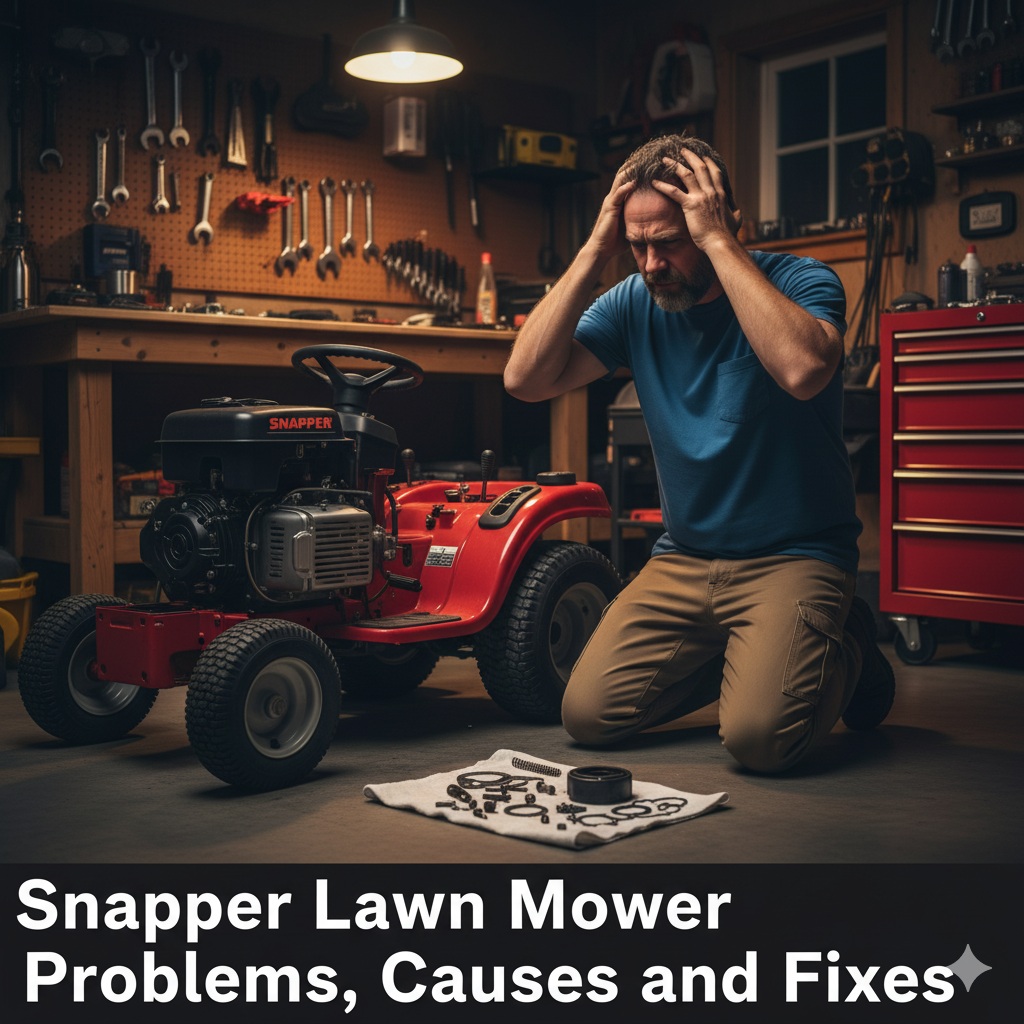
Snapper is one of the oldest and most trusted names in lawn care. Known for its rugged construction, user-friendly design, and reliable performance, Snapper mowers — whether push, self-propelled, or zero-turn models — are a favorite among homeowners and professionals alike.
However, like any mechanical equipment, Snapper lawn mowers can develop issues over time due to wear, improper maintenance, or fuel and electrical system problems.
In this comprehensive guide, we’ll explore the most common Snapper lawn mower problems, their causes, fixes, and preventive maintenance tips, including model-specific insights for Snapper walk-behind, riding, and zero-turn mowers.
⚙️ Overview of Snapper Lawn Mowers
Snapper manufactures several mower types designed for different applications:
| Category | Model Examples | Engine Type | Cutting Width | Ideal For |
|---|---|---|---|---|
| Walk-Behind (Push & Self-Propelled) | Snapper Hi-Vac, Ninja, XD 82V | Briggs & Stratton, Honda | 19–21 in | Small–medium lawns |
| Riding Lawn Mowers | Snapper RE100, SPX, 360Z XT | Briggs & Stratton, Kawasaki | 30–52 in | Medium–large yards |
| Zero-Turn Mowers | Snapper 360Z, ZTX 105, ZTX 275 | Kawasaki, Briggs Commercial | 42–61 in | Large lawns, professional use |
| Battery/Electric Mowers | Snapper XD 82V Max | Lithium-ion | 19–21 in | Quiet, eco-friendly operation |
Snapper’s equipment is known for its durability, but certain recurring problems affect all models. Let’s dive into the most common issues, their causes, and how to fix them effectively.
🔍 Common Snapper Lawn Mower Problems, Causes, and Fixes
1. 🚫 Snapper Mower Won’t Start
🔎 Causes:
- Stale or old fuel
- Dirty carburetor or clogged fuel filter
- Faulty spark plug
- Safety switch not engaged
- Dead battery (on riding/electric models)
🔧 Fixes:
- Check the Fuel:
- Drain stale gas from the tank and carburetor.
- Refill with fresh unleaded fuel (use fuel stabilizer if stored long-term).
- Clean or Replace Spark Plug:
- Remove and clean carbon deposits using a wire brush.
- Replace if corroded or cracked (gap: 0.030”).
- Clean Carburetor:
- Remove the bowl and spray carb cleaner through the jets.
- Reinstall using new gaskets if needed.
- Battery Check (Riding/Electric):
- Charge battery to full voltage (12.6V for lead-acid).
- Clean terminals with baking soda and water.
- Engage Safety Switches:
Ensure the parking brake is set, seat is occupied, and blades are disengaged.
💡 Tip: If your mower only starts with starter fluid, the carburetor is likely clogged or fuel flow is restricted.
2. 🔋 Battery or Electrical Problems (Riding and Electric Models)
🔎 Causes:
- Dead or weak battery
- Loose or corroded connections
- Faulty voltage regulator or alternator
- Damaged wiring or fuse
🔧 Fixes:
- Clean Terminals:
Corrosion prevents proper charging — scrub with baking soda and a wire brush. - Test Voltage:
- Engine off: 12.6V
- Engine running: 13.8–14.2V
- If voltage doesn’t increase while running, replace the regulator or alternator.
- Check Wiring and Fuses:
Replace any burnt fuses or damaged wires. - For Electric Models:
- Ensure charger connection is secure.
- Replace batteries every 3–4 years for best performance.
⚙️ Applies to: Snapper XD 82V, RE100, 360Z, and SPX riding mowers.
3. 🌀 Engine Stalling or Surging
🔎 Causes:
- Clogged fuel line or carburetor
- Air leak in intake manifold
- Dirty air filter
- Faulty governor spring
🔧 Fixes:
- Clean Fuel System:
- Replace old gas.
- Clean carburetor thoroughly.
- Inspect and replace fuel filter if dirty.
- Replace Air Filter:
A clogged filter causes the engine to run rich — replace every 25 hours. - Inspect Governor Linkage:
Adjust or replace worn springs causing unstable RPMs. - Tighten Carburetor Bolts:
Air leaks at the intake gasket can cause surging.
⚠️ Common in: Snapper SPX 42, 360Z, and Ninja self-propelled mowers.
4. 🌿 Uneven or Poor Cutting Quality
🔎 Causes:
- Dull or bent blades
- Unleveled deck
- Uneven tire pressure
- Grass buildup under deck
🔧 Fixes:
- Sharpen or Replace Blades:
Sharpen blades every 25 hours. Replace if nicked or warped. - Level the Deck:
- Measure from blade tip to ground on both sides.
- Adjust lift links until deck is level.
- Check Tire Pressure:
Low or uneven pressure causes the deck to tilt. - Clean Deck Underside:
Remove caked grass to restore airflow and suction.
💡 Tip: Snapper’s Hi-Vac system relies on airflow — keeping the deck clean ensures consistent suction.
5. 🧩 Drive or Self-Propel System Not Working
🔎 Causes:
- Broken or loose drive belt
- Damaged transmission cable
- Worn wheel gears (push/self-propel models)
- Hydrostatic fluid low (riding models)
🔧 Fixes:
- Inspect Drive Belt:
- Replace if cracked, glazed, or slipping.
- Ensure it’s properly tensioned.
- Adjust or Replace Drive Cable:
- Tighten cable tension.
- Replace if frayed or stretched.
- For Riding Mowers:
- Check hydrostatic oil level.
- Purge air from system (raise rear wheels, cycle controls).
- Wheel Gears:
Replace worn or stripped gears in self-propelled models.
⚙️ Common in: Snapper Ninja 21SP and SPX 38 Riding Mowers.
6. 🔊 Excessive Vibration or Noise
🔎 Causes:
- Unbalanced blade or bent spindle
- Loose bolts or mounting hardware
- Worn bearings or pulleys
- Debris under deck
🔧 Fixes:
- Check Blades and Spindles:
Replace bent blades or worn spindle bearings. - Tighten All Bolts:
Especially around engine mounts, handle assembly, and deck pulleys. - Clean Deck Thoroughly:
Stuck debris often causes vibration.
⚠️ Prolonged vibration can damage deck housings — inspect regularly.
7. 🔥 Mower Smoking or Overheating
🔎 Causes:
- Overfilled oil or oil leak
- Clogged air filter
- Blocked cooling fins
- Worn piston rings
🔧 Fixes:
- Check Oil Level:
Drain excess oil if above full mark. - Clean Cooling Fins:
Blow out dirt and grass clippings with compressed air. - Replace Air Filter:
A clogged filter makes the engine run rich and emit black smoke. - Persistent Blue Smoke:
Indicates oil burning — consult service technician.
⚡ Tip: Avoid tipping mower sideways; always tilt with carburetor facing up.
8. ⚙️ Blades Not Engaging (PTO Issues)
🔎 Causes:
- Faulty PTO clutch or switch
- Blown fuse
- Loose wiring
- Worn deck belt
🔧 Fixes:
- Inspect PTO Switch and Fuse:
Replace if burnt or corroded. - Check Belt:
Replace if frayed or off pulleys. - Test Clutch:
Apply 12V to the clutch — if it doesn’t engage, replace the unit.
⚙️ Applies to: Snapper SPX and 360Z riding mowers.
9. 🚜 Mower Won’t Move or Feels Sluggish
🔎 Causes:
- Drive belt broken or slipping
- Hydrostatic transmission low on oil
- Parking brake stuck
- Debris blocking pulleys
🔧 Fixes:
- Replace Drive Belt:
Use OEM Snapper belts for proper fit. - Check Transmission Fluid:
Refill and purge system if air is trapped. - Clean and Lubricate Brake Linkage:
Rust or debris can cause the brake to stay partially engaged.
💡 Tip: On zero-turn models, ensure the bypass lever is not in “freewheel” mode.
10. 🧲 Snapper Engine Backfiring or Hard Starting
🔎 Causes:
- Timing off due to sheared flywheel key
- Stale fuel or incorrect octane
- Dirty carburetor or valves sticking
- Spark plug gap incorrect
🔧 Fixes:
- Replace Flywheel Key:
If backfire occurs suddenly after hitting an object. - Clean Carburetor & Replace Fuel:
Use fresh fuel only. - Adjust Valves:
Valve clearance (Kawasaki/Briggs engines): 0.005”–0.007”. - Replace Spark Plug:
Gap properly and install snugly.
🧩 Model-Specific Snapper Problems & Fixes
| Model | Common Issues | Likely Causes | Recommended Fixes |
|---|---|---|---|
| Snapper Hi-Vac 21” | Poor suction / uneven cut | Clogged deck, dull blades | Clean deck, sharpen blades |
| Snapper Ninja | Self-propel not working | Worn belt or drive cable | Replace drive belt or adjust cable |
| Snapper XD 82V Max | Battery drains fast | Weak battery or improper charging | Replace battery, avoid extreme temps |
| Snapper RE100 Rider | Mower won’t start | Faulty seat switch or fuel issue | Check safety switches, clean carb |
| Snapper SPX 42 / 48 | Belts slipping / vibration | Worn pulleys, misalignment | Replace belt, check pulley alignment |
| Snapper 360Z | PTO clutch failure | Bad clutch coil | Replace PTO clutch |
🧰 Routine Maintenance Tips
| Interval | Maintenance Task |
|---|---|
| After each use | Clean deck, check for leaks, remove grass buildup |
| Every 25 hours | Sharpen blades, inspect belts and tires |
| Every 50 hours | Change oil, clean air filter, check spark plug |
| Every 100 hours | Replace oil filter and fuel filter |
| Annually | Replace belts if worn, grease fittings, service transmission |
🧠 Tip: Keep a maintenance log to track oil changes and part replacements — this improves reliability and resale value.
💵 Estimated Repair Costs (U.S. Average)
| Repair Type | DIY Cost | Professional Cost |
|---|---|---|
| Blade sharpening/replacement | $25–$40 | $80–$120 |
| Belt replacement | $30–$60 | $100–$150 |
| Battery replacement | $60–$100 | $150–$200 |
| Carburetor cleaning | $10–$20 | $80–$120 |
| PTO clutch replacement | $150–$250 | $300–$500 |
| Hydrostatic repair | $100 | $400–$700 |
⚠️ When to Seek Professional Help
- Engine knocking or metallic noises
- Persistent smoke or oil burning
- Electrical shorts or sparks
- Hydraulic leaks or loss of drive power
- PTO clutch not engaging even after voltage check
Authorized Snapper dealers and Briggs & Stratton service centers can diagnose deeper engine or transmission problems under warranty.
🧠 Preventive Tips for Long Life
- Use fresh, ethanol-free fuel or fuel stabilizer.
- Keep air filters and blades clean to reduce strain.
- Store mower indoors or under a waterproof cover.
- Lubricate cables, pulleys, and spindles regularly.
- Avoid mowing wet grass to prevent clogging.
- Follow manufacturer service intervals and use OEM parts only.
✅ Following these steps can extend your Snapper mower’s lifespan to 10–15 years with consistent performance.
✅ Final Thoughts
Snapper mowers — whether the Hi-Vac push mower, SPX riding mower, or 360Z zero-turn — are built to last. Most common issues such as starting problems, belt wear, vibration, or uneven cuts arise from normal use and can be easily fixed with basic maintenance.
By following regular maintenance schedules, using fresh fuel, and promptly addressing small issues, you’ll keep your Snapper mower running efficiently season after season.
In short, Snapper mowers are reliable workhorses — treat them right, and they’ll reward you with years of smooth, consistent lawn care.
📚 References
- Snapper Official Support – https://www.snapper.com
- Snapper Owner’s Manuals and Parts Finder – https://www.snapper.com/na/en_us/manuals.html

I’m David man behind Lawn Mowerly; I’ve been dealing with lawnmowers and Tractors with my father since I was a kid. I know every make and model and what each one is capable of and love helping people find the perfect equipment for their needs.
